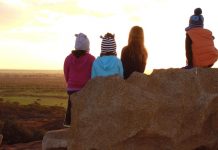Bushfires have dominated news reports in Australia for the past few months, and while Western Australia has been fairly lucky so far this summer compared to other states, we are still experiencing hot and dry conditions that mean we are at risk of bushfires.
Any experienced camper will know that in the summer months you do not light a campfire; and now more than ever, this is a hard and fast rule that must be obeyed. The last thing firies need is catastrophic bushfires just because someone had a campfire that got out of control.
In cooler months, campfires are one of the best things about camping. But if a campfire is not constructed, used and extinguished correctly it can also easily cause a bushfire.
The Department of Fire and Emergency Services advises before you even light a fire, to check the weather conditions in your camping area and do not light or maintain a campfire on dry, windy days. Observe fire danger ratings and don’t light a campfire of the rating is very high, severe, extreme or catastrophic. And of course never light a campfire during a total fire ban.
However of the conditions are right, campfires can be lit. Here’s some tips from DFES on building your campfire safely:
- Camp in a safe location that is clear of flammable vegetation such as long grass and spinifex.
- Use a built fireplace where provided, or dig a 30cm deep trench to house the fire and prevent embers from flying out.
- Create a border around the fire using large rocks.
- Light the campfire in a cleared area. Remove branches, leaves and twigs from the ground and above the flames to create a clearing of three metres around the fire.
- Ensure the fire is three metres away from tents; and make sure other camping equipment is stored well away, especially flammable items such as gas cylinders and fuel cans.
- Never use flammable liquid or fuel such as petrol or diesel on a fire even when you are trying to get it started.
Your campfire should only be kept big enough for cooking and keeping warm, and you should never leave it unattended. Children and pets should be well supervised around a fire. You should put your fire out at night-time as many children have been burned by hot ashes and embers the following morning.
When putting out a campfire, you should always use water and never soil – fires can still smoulder under soil and can stay hot for more than eight hours, meaning they are a danger to anyone walking in the area once you have gone.
Fire safety is important in day-to-day life, but requires even more attention when you are camping. Following good fire procedures will mean less burns, less damage and less bushfires, which is something all Aussies want right now.



























